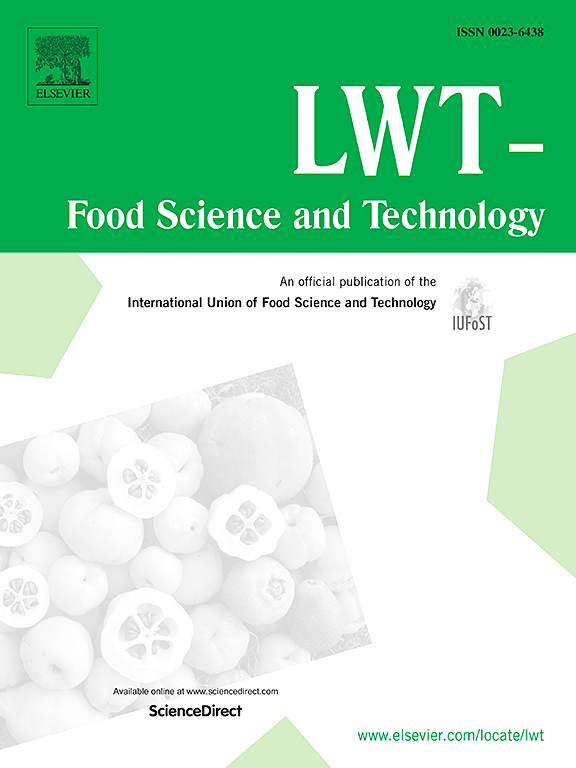Production of nattokinase and γ-polyglutamic acid via soybean whey fermentation by Bacillus subtilis BSNK-5 and their emulsification to form nanoemulsions
IF 6
1区 农林科学
Q1 FOOD SCIENCE & TECHNOLOGY
引用次数: 0
Abstract
Soybean whey, a nutrient-rich byproduct generated during the production of soybean protein isolate, can only be discharged after undergoing sewage treatment, which imposes a significant economic burden on enterprises. In this study, we investigated a Bacillus subtilis BSNK-5 fermentation soybean whey process that yielded high production of nattokinase (NK) and γ-polyglutamic acid (γ-PGA), along with the fabrication of an emulsion using fermentation soybean whey, to achieve high-value conversion of soybean whey. The results showed that soybean whey can be used as a nutrient-rich substrate to promote the efficient synthesis of NK and γ-PGA by BSNK-5, with the highest yields of 9 × 104 IU/mL and 250 g/L, respectively. Meanwhile, the synthesized γ-PGA can serve as a suitable biological macromolecule to form an emulsification system that protects NK. The encapsulation efficiency of NK was over 60%, and the release of encapsulated NK was delayed in vitro. Meanwhile, the nanoemulsions remained stable when exposed to 37 °C and 65 °C temperatures, salt concentrations ranging from 50 to 150 mM, and undergoing a single freeze-thaw cycle. The development of functional thrombolytic preparations by self-emulsification protection of NK by γ-PGA produced via BSNK-5 fermentation represents an effective way to achieve high value utilization of soybean whey.

枯草芽孢杆菌 BSNK-5 通过大豆乳清发酵生产纳豆激酶和 γ-聚谷氨酸,并将其乳化形成纳米乳液
大豆乳清是大豆分离蛋白生产过程中产生的一种营养丰富的副产品,只有经过污水处理后才能排放,这给企业带来了巨大的经济负担。在本研究中,我们研究了枯草芽孢杆菌 BSNK-5 发酵大豆乳清工艺,该工艺能产生较高的纳豆激酶(NK)和γ-聚谷氨酸(γ-PGA)产量,并能利用发酵大豆乳清制造乳液,实现大豆乳清的高价值转化。结果表明,大豆乳清可作为营养丰富的底物,促进 BSNK-5 高效合成 NK 和 γ-PGA,最高产量分别为 9 × 104 IU/mL 和 250 g/L。同时,合成的γ-PGA可作为合适的生物大分子,形成保护NK的乳化体系。NK 的包封效率超过 60%,且包封的 NK 在体外释放延迟。同时,纳米乳液在 37 °C、65 °C、50 至 150 mM 的盐浓度以及单次冻融循环下均保持稳定。通过BSNK-5发酵产生的γ-PGA对NK进行自乳化保护来开发功能性溶栓制剂,是实现大豆乳清高值化利用的有效途径。
本文章由计算机程序翻译,如有差异,请以英文原文为准。
求助全文
约1分钟内获得全文
求助全文
来源期刊

LWT - Food Science and Technology
工程技术-食品科技
CiteScore
11.80
自引率
6.70%
发文量
1724
审稿时长
65 days
期刊介绍:
LWT - Food Science and Technology is an international journal that publishes innovative papers in the fields of food chemistry, biochemistry, microbiology, technology and nutrition. The work described should be innovative either in the approach or in the methods used. The significance of the results either for the science community or for the food industry must also be specified. Contributions written in English are welcomed in the form of review articles, short reviews, research papers, and research notes. Papers featuring animal trials and cell cultures are outside the scope of the journal and will not be considered for publication.
文献相关原料
| 公司名称 | 产品信息 | 采购帮参考价格 |
|---|---|---|
| 上海源叶 |
Soybean oil
|
|
| 上海源叶 |
Dinitrosalicylic acid (DNS)
|
|
| 上海源叶 |
Tween 80
|
 求助内容:
求助内容: 应助结果提醒方式:
应助结果提醒方式:


